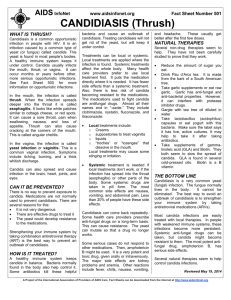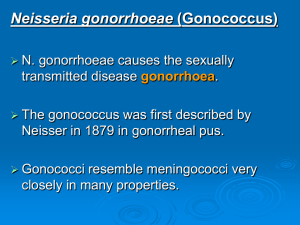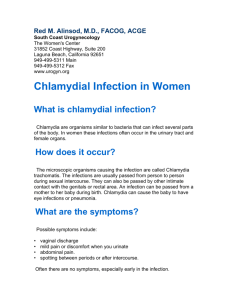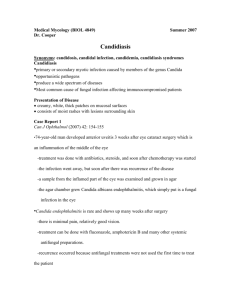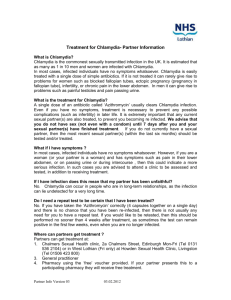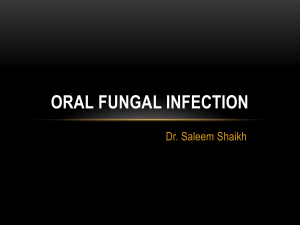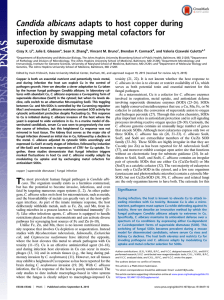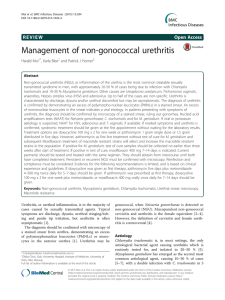3,4Chlamydia trachomatis, Mycoplasma, Ureaplasma, NGU
advertisement
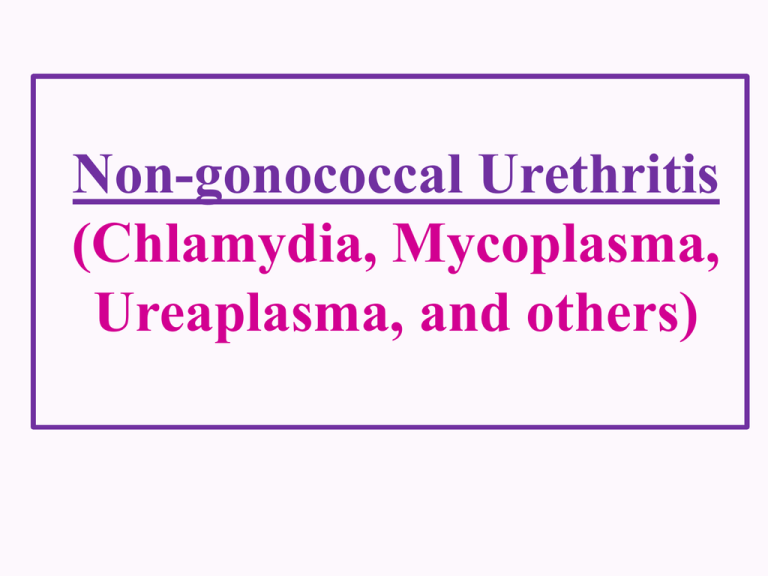
Non-gonococcal Urethritis (Chlamydia, Mycoplasma, Ureaplasma, and others) Chlamydia trachomatis Microscopy and culture: Small round-to-ovoid bacteria. Obligatory intracellular parasite (depends on the host cellular energy ATP, and NAD). Cultured in embryonated eggs or tissue culture. Rigid cell wall although it does not contain peptidoglycan or muramic acid. Cannot be stained by gram stain. Inclusion bodies retain Iodine or safranin. Tow forms: elementary body (EB) and reticulate body (RB). Pathogenesis and life cycle: Transmission: Sexual route. Infectious form: The elementary body (E.B). • The E.B enters by phagocytosis into columnar epithelial cells of endocervix and macrophages (E.B prevents phagosome lysosomes fusion). • Inside the cells the E.B differentiates to the metabolically active dividing reticulate body (RB) (diagnostic stage; inclusion bodies). • After 48 hours, infected cells will rupture to release many elementary bodies resulting in host cell death, and infection of other cells. 0 -5 hours 48 hours 24-30 hours n Chlamydia inclusions: Reticulate body. Serotypes and Tissue Damage: • Chlamydia trachomatis has several serovars: A-L. Chlamydial infections: Eye infection (trachoma): serotypes A, B and C. Genital tract infections: o Nongonococcal urethritis (discharge): Caused by: serovars: D- K. o Lymphogranuloma venereum:(LGV): Caused by serovars: L1, L2, and L3. more invasive infection. Nongonococcal urethritis: Discharge: More mucus fewer pus. In male: o Urethritis, the infection may extend to epididymitis and prostatitis but rarely to the testes (orchitis). o One-third of patients have Reiter syndrome (HLA-B27; acute aseptic arthritis and urethritis). In Female: o Cervicitis and pelvic inflammatory disease. o Most of the cases are asymptomatic. o Exposure to ineffective antibiotics or interferon-γ may results in persistence infection. o Infertility and ectopic pregnancy. N Lymphogranuloma venereum (LGV): • Invasive infection caused by serovars: L1, L2, and L3. • Clinical presentation: o Papules and then herpetic-like ulcers are formed on the external genitalia and persist for one to two months (more invasive infection). o Painful swelling of inguinal and perirectal lymph nodes (bubo). Cervical adenopathy (oral sex) o Lymphatic obstruction; elephantiasis of genitalia. DD of genital ulcers: chancer, chancroid, genital herpes, trauma, drug sensitivity. Clinical picture of Chlamydia trachomatis: Urethral discharge : (more mucoid with fewer pus cell). Chlamydial Cervicitis. LGV penile ulcer Inguinal adenopathy Diagnosis of Chlamydia trachomatis infection: • Clinical specimens: Urethral discharge, HVS, endocervical swab, urine (scraping of the epithelial or squamocolumnar junction) • Direct microscopy: A-Immunofluorescent microscopy. B-Electron microscopy. • Culture: cell culture or embryonated eggs culture. • Detection of chlamydia genetic material by PCR. • Serology: helpful only in LGV. Treatment: Doxycycline, azithromycin, erythromycin Electron microscopy Immunofluorescent staining of inclusion body. Immuno-electrone microscopy Mycoplasma hominis, Mycoplasma genitalium, and Ureaplasma urealyticum Mycoplasma& Ureaplasma • The smallest prokaryotic microbe capable of growth on cell-free media. • Extremely small size (0.1-0.3 micrometer): pass through sterilization filters. Small Ds DNA. • Lack cell wall: No peptidoglycan. o Elastic and pleomorphic (cannot be classified as cocci or bacilli). o Resistance to penicillin and cephalosporins. • Cell membrane: lipid bilayer membrane containing sterols (should add cholesterol to the culture media). • M. hominis and U. urealyticum are UG tract flora. n Cultural characteristics and colony morphology: o Facultative anaerobes, some species are strict anaerobes. o Can be grown in cell-free media. o Fastidious: need cholesterol (serum). o Colonies are visualized microscopically. And show a characteristics fried egg appearance. o Biochemical activities: • M. hominis degrades arginine for energy. • U. urealyticum hydrolyses urea to ammonia which destroys the epithelial cells. Mycoplasma and Ureaplasma infections: In female: • M. hominis cause PID, postpartum and post abortion fever. • U. urealyticum and M. genitalium are associated with cases of PID; endometritis and bacterial vaginosis. In male: • Ureaplasma urealyticum and Mycoplasma genitalium: Urethritis. The infection can disseminate to other tissues in immunocompromised patients. Treatment: • U. urealyticum and M. genitalium: sensitive to azithromycin. • M. hominis: Erythromycin and azithromycin resistance. nd 2 Lecture Bacterial vaginosis: • The most common vaginal infection worldwide. • Disruption of vaginal normal flora (Lactobacillus). • Causative agents: o Gardnerella vaginalis: gram-variablestaining facultative anaerobic coccobacilli. o Mycoplasma species and other bacterium. • Other causes of vaginal infection (vaginitis): - Candidiasis. - Protozoan infection: Trichomonas vaginalis. Normal Vagina Bacterial vaginosis Vaginal Candidiasis • Thin-walled, yeasts reproduce mainly by budding. • Candida spp. are members of the normal flora. • Candidiasis is the most common opportunistic mycoses worldwide (cellular immunity protects against mucocutaneous candidiasis, neutrophils protect against invasive candidiasis) • More than 150 species of candida but only few species cause disease in humans. • The species of most medical significance are: o Candida albicans. o Candida tropicalis. Clinical presentation of Candida albicans: Candida albicans causes most of the cases of oropharyngeal candidiasis and vulvovaginal candidiasis. • In female: Vaginal candidiasis: • Itching and burning pain of the vagina. • Thick or thin white discharge (cheesy). • In male: Urethritis. Morphology and cultural characteristics: o Microscopically: Candida albicans is a dimorphic fungi, reproduce mainly by budding, but can produce pseudohyphae and true hyphae. o Culture: after 24 hours at 37 C or room temperature, white, creamy, rounded colonies with feet projection or regular margin appears. Asexual germination of candida occurs by production of blastopores or chlamydiospores. o Germ tube test: To differentiate C. albicans from other spp. C. albicans produce germ tube (true hyphae) when incubated with serum at 37ᴼ C for 90 minutes. Asexual germination: blastopores & chlamydiospores Germ tube Trichomoniasis: Trichomonas vaginalis. o Classification: Protozoa: class Mastigophora. o Morphology: oval or pyriform in shape, with short undulating membrane, axostyle & four free flagella o Reproduce by binary fission. Transmission: sexual and contaminated clothes. Pathology and clinical picture: Urethritis: in male and female. Vaginitis: itching, copious- yellowish offensive discharge. Prostatitis and seminal vesiculitis in male. Diagnosis: Detection of the trophozoite in vaginal or urethral discharge. Congenital and Perinatal infections: Congenital (intrauterine or prenatal) infections are those transmitted transplacentally. The causative agents are: - Cytomegalovirus. - Herpes simplex virus. - HIV. - Parvovirus B19. - Rubella virus. - Treponema pallidum. - Toxoplasma gondii. The effect of intrauterine infections on the fetus: Abnormal organogenesis: rubella: structural abnormalities in tissue and organs; defects in retina, pulmonary artery stenosis. Inflammatory response results in tissue damage: CMV and T.gondii: cause cerebritis (encephalitis); so cerebral atrophy and intracranial calcification. Placental insufficiency: low birth weight, premature birth, fetal death. N Perinatal infections: acquired at birth or during the first four weeks after birth from maternal or non-maternal sources. Causative agents: - E.coli and other Enterobacteriaceae. - Group B Streptococci and Listeria monocytogenes. - Gonococci and Chlamydia. - Viruses. - Candida. Effects: Bacterial sepsis: Mortality rate is 10-40%. Meningitis: neurological damage: in 20-50% of survivors.

